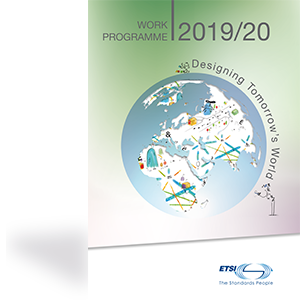
ETSI Work Programme 2019/20 - Spotlight on 5G
ETSI is a founding partner of the Third Generation Partnership Programme (3GPPTM), uniting with six other standardisation organisations around the globe to develop specifications for advanced mobile communications technologies. 3GPP activities focus on radio access, core transport network and service capabilities, spanning codecs, quality of service (QoS), security and much more. 3GPP members via ETSI account for well over half of total membership.
In the period 2019/20, ETSI's activities focus on supporting the timely technical and market success of 5G, the next mobile generation, as reported in the ETSI Work Programme 2019/20 - Designing Tomorrow's World.
Building Blocks for 5G
Significant factors for the commercial and environmental viability of 5G are:
- Network Functions Virtualisation (NFV), Multi-access Edge computing (MEC) and Experimental Networked Intelligence (ENI) as the crucial building blocks for the long-term commercial success of 5G.
- Investing the use of spectrum resources in the millimetre range to help meet future demand for 5G services.
- Developing standards for monitoring and controlling power consumption in 5G networks.
Milestones - 3GPP Release 15
- This is the first full set of 5G standards.
- Rel-15 covers 'standalone 5G' with a new radio system (NR) complemented by a next-generation core network.
- Enhancements to LTE, and, implicitly, the Evolved Packet Core (EPC).
This crucial milestone has enabled vendors to progress rapidly with chip design in anticipation of initial network implementations in 2019.
Release 16 (aka '5G Phase 2') - Study and Work Items
Work on Rel-16 has accelerated in 2019, with over 70 studies underway across the various phases in 3GPP. Topics include:
- Multimedia Priority Service.
- Vehicle-to-everything (V2X) application layer services.
- 5G satellite access.
- Local Area Network support in 5G.
- Wireless and wireline convergence for 5G.
- Terminal positioning and location.
- Communications in vertical domains.
- Network automation.
- Novel radio techniques.
- Other items under study include codecs and streaming services, security, Local Area Networking interworking, network slicing and IoT.
Release 16 - Mission Critical Services and Vertical Sectors
- Expansion to a wider business sector beyond the initial public security and civil defence services, for which MC services were originally developed.
- The main driver is bringing enhanced reliability to MC services through wider deployment and lower deployment costs through economies of scale for other commercial applications based on the same or similar standards. Examples include taxi dispatching, rail traffic management and other vertical sector scenarios that are currently being investigated.
- The development of Technical Reports (TRs) are aimed at broadening the applicability of 3GPP technology to non-terrestrial radio access. The initial focus is on satellites, but airborne base stations are also considered, as well as maritime aspects (intra-ship, ship-to-shore and ship-to-ship.
- Progress on new Professional Mobile Radio (PMR) functionality for LTE, enhancing the railway-oriented services originally developed using GSM radio tehnology but now nearing end of life.
Release 17 - More 5G system enhancements
Rel-17 studies consider:
- 5G LAN.
- High-precision positioning.
- 5G IoT.
- Evolved ultra reliable and low latency communications.
- Network controlled interactive services.
- Communication services for critical medical applications.
- Asset tracking.
- Relays for energy efficiency and extensive coverage.
- Application layer support for 5G factories.
- Enhancements for cyber-physical control applications in vertical domains.
- Support for multi-USIM devices.
- Unmanned aerial systems connectivity-identification tracking.
- Minimisation of service interruption.
- Audio/visual service production.
- Multimedia priority service Phase 2.
- Architectural enhancements for 5G multicast-broadcast services.
- Service-based support for SMS in 5G core.
- Edge computing/applications in 5G core.
- Application Architecture for enabling edge applications.
- User plane function enhancements for the service-based architecture.
To keep track of 3GPP progress on 5G Study and Work Items from specialists in the 5G-IA Pre-Standardization WG, see our 3GPP Plenary Debriefs.



